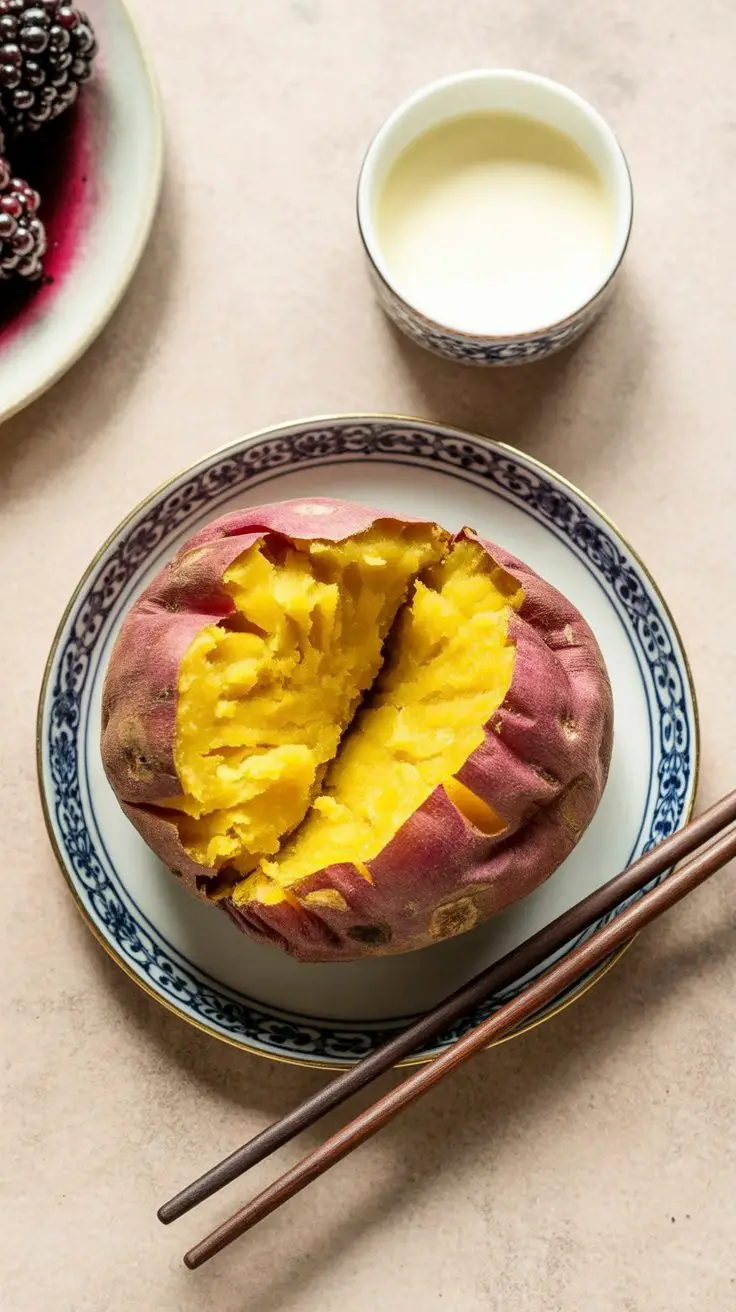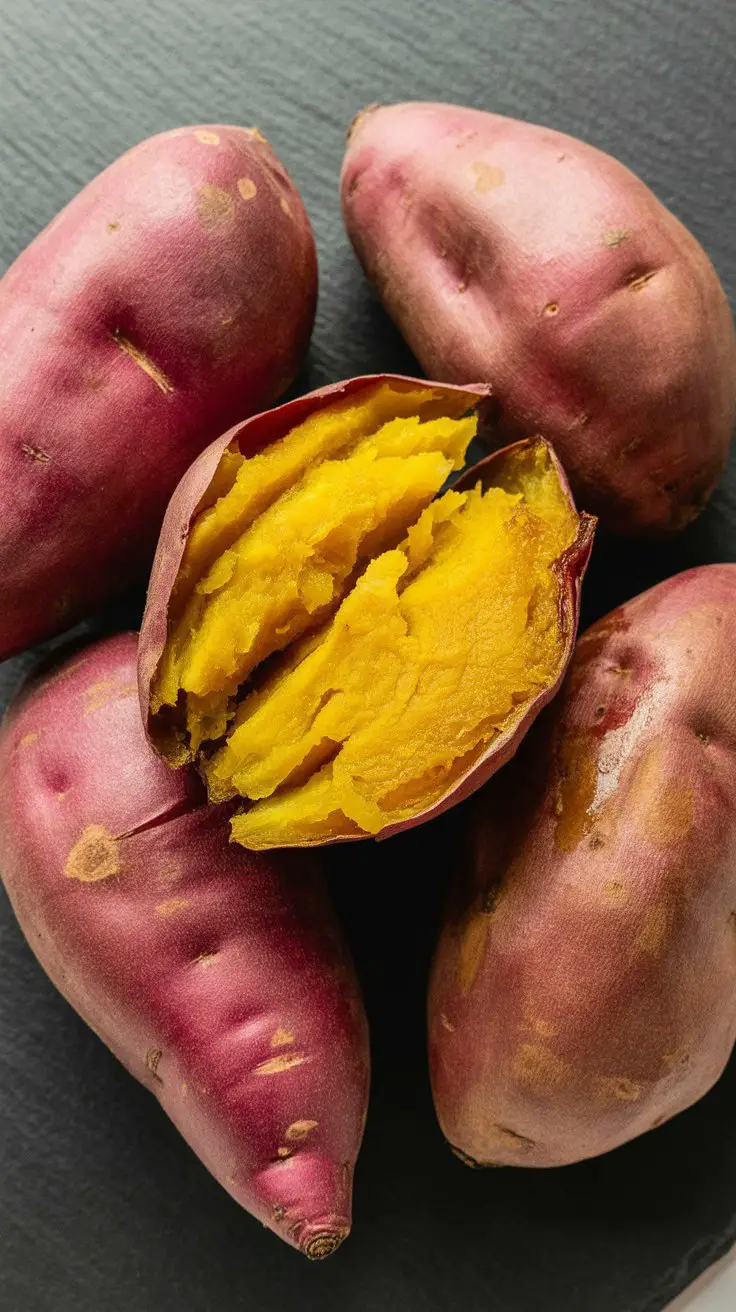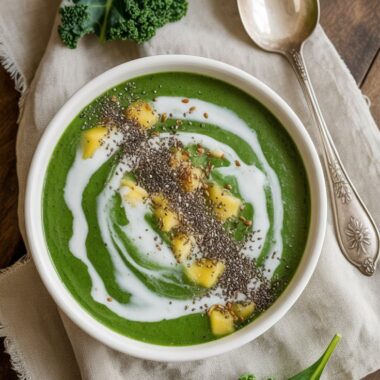There’s something about Japanese sweet potatoes that makes them feel like a hug in food form. Sweet, creamy, and satisfying, they’re one of those simple pleasures I never get tired of. Around my kitchen, these are a cold-weather staple. I bake a bunch at once, stash them in the fridge, and they become breakfast, snack, or even a side dish for dinner. Whether I’m in the mood for something sweet or savoury, they always deliver.

What Makes Japanese Sweet Potatoes Special
If you’ve never had Japanese sweet potatoes (Satsumaimo), you’re in for a treat. They’ve got a beautiful reddish-purple skin with a creamy white inside that turns golden after baking. The taste? Naturally sweet—almost like caramel cake—and the texture is more dry and fluffy than orange sweet potatoes. I’d say it’s closer to a chestnut than anything else.
I remember the first time I had one fresh out of a street cart in Japan—wrapped in newspaper, still steaming. It tasted like dessert without the guilt. That’s when I was hooked.
Japanese vs. Orange Sweet Potatoes
Here’s how I’d explain it to a friend: orange sweet potatoes are great for mash or pie because they’re soft and moist, like pumpkin. But Japanese sweet potatoes are dry and dense, almost like a baked cake. They don’t need much fuss. Roast one properly and it gets naturally caramelized, even oozing syrupy sugar at the edges. That’s what sets them apart.
The flavour is nutty and deep—think roasted chestnuts or a mild sweet hazelnut. They work great in both sweet and savoury recipes.
Are They Actually Healthy?
Absolutely. Aside from being delicious, they’re packed with slow-burning carbs, which means they’ll actually keep you full. I often eat one in the afternoon to get me through the evening slump.
Here’s the breakdown for a medium potato (around 200g):
264 calories
2.4g protein
0.4g fat
63g carbs
4.6g fibber
They’re full of vitamins A, C, and B6—great for skin, energy, and immunity. And because they’re so filling, they make a great swap for processed snacks.
Where I Buy Them
I usually find them at my local Asian grocer or sometimes in the international section of big supermarkets. Trader Joe’s in the US often carries them, and I’ve even spotted them in some weekend farmers’ markets. Look for the ones with smooth, unblemished skin and go for medium-sized ones—those bake the best.
Just a note: don’t confuse these with Okinawan sweet potatoes—they’re purple on the inside, completely different taste and texture.
Storing Raw Sweet Potatoes
The best way to store them? Keep them in a cool, dark corner of your kitchen—never the fridge. Mine go into a paper bag in the pantry where they stay good for around 3 weeks. Once baked, they go into the fridge, but more on that below.
How I Bake Japanese Sweet Potatoes (and You Should Too)
There are quite a few ways to cook them, but baking is hands-down my favourite. It brings out their natural sweetness and gives that fluffy, cake-like texture that makes them feel like a treat—even though they’re just potatoes!
Oven Baking (My Go-To)
Here’s what I do on Sundays while I prep the week’s meals:
325°F (162°C) for 70–90 minutes (my favourite method): This gives a fluffy, almost cake-like texture. Super sweet. Wrap them in foil if you want that soft, steamy middle.
375°F (190°C) for 50–65 minutes: You get a slightly crisper skin, like roasted cheesecake on the outside, still buttery inside.
My personal routine: bake at 325°F wrapped in foil, then reheat at 375°F unwrapped for that balance of soft and crispy.
Toaster Oven
Great if you’re doing just one or two. Set it to 400°F (200°C) and let them roast for 45–60 minutes. If you like a deeper, nutty flavour and crispy edges, this is the method to go with. I sometimes use newspaper and foil, just like the old-school Yaki Imo style.
Stove Top in a Cast Iron Pan
When I don’t want to heat up the whole oven (especially in summer), I’ll pop one in my cast iron skillet, wrap it in foil, cover it, and cook it on low for about 60 minutes. Flip every 20 minutes or so. You’ll know it’s ready when a chopstick slides in easily. Let it rest for 10 minutes before eating—it gets creamier that way.
Microwave (Only With a Ceramic Sweet Potato Pot)
I’ve tried microwaving them directly and it just dries them out. If you have one of those Japanese ceramic sweet potato pots, they do the trick! Microwave for 5–8 minutes, let them sit inside for another 5, and you’ll get a surprisingly nice texture.

Steaming or Instant Pot (Only If You’re Using Them for Something Else)
If you’re making mashed sweet potatoes or adding them to soup, sure—use the steamer or Instant Pot. But for eating on their own? They get too wet and lose that lovely texture.
Real-Life Tips From My Kitchen
Don’t poke them before baking—I used to do this thinking it helps cook faster, but it actually slows things down and messes with the sugar caramelizing.
No foil = crispy skin. Foil = soft, cakey inside. Decide what texture you’re after.
Always let them rest after cooking—this finishes the bake and makes sure they’re evenly cooked inside.
For storage: Let them cool fully, then store in the fridge for up to 5 days. I wrap them in parchment paper and pop them in a container. You can even freeze them—just thaw at room temp.
How I Love Eating Them
Most days, I just peel one and eat it as-is, straight from the fridge or after a quick reheat. It’s sweet enough to feel like dessert, but hearty enough to count as a real snack.
When I want a twist, I drizzle a little tahini or almond butter on top. It balances out the sweetness and adds creaminess. Sometimes I’ll even slice them and pan-sear the slices in a little ghee—so good with scrambled eggs.
If you’re going savoury, stuff them with sautéed mushrooms, spinach, or even leftover chicken curry. Or slice and toss them with spices to make fries.
For sweets, mash them into batter for pancakes, bake into muffins, or use them in a smoothie for that rich, creamy texture.

Final Thoughts
Baking Japanese sweet potatoes might seem simple, but the little details really make a difference. Whether you’re enjoying them on their own or turning them into something creative, they’re a reliable, comforting ingredient that deserves a regular spot in your kitchen.
Let me know how you like them best—or better yet, try a batch this week and keep a few in the fridge. I promise, future-you will be thankful every time hunger hits.
Perfect Baked Murasaki Sweet Potatoes

There’s nothing quite like biting into a perfectly baked Japanese sweet potato — crisp and golden on the outside, warm and sweet like cake on the inside. Whether you're cozying up on a chilly day or just craving a wholesome snack, these are a personal favourite I keep coming back to.
Ingredients
- 5 Japanese sweet potatoes (medium size, around 250–350g each)
Instructions
- Start by giving the sweet potatoes a good rinse and pat them dry with a kitchen towel. Using a fork, poke a few holes all around each potato to let steam escape as they bake.
- You can either wrap them loosely in foil or leave them uncovered, depending on how you like the texture.
- Place the sweet potatoes directly on the oven rack or a baking tray. No need to preheat the oven. Set the temperature to 325°F and bake for about 70–90 minutes, or go with 375°F for a slightly quicker bake, around 50–65 minutes. You’ll know they’re ready when a chopstick or skewer glides right through them with no resistance.
- Once baked, turn off the oven but leave the potatoes inside with the door closed. Let them rest for about an hour — this extra step makes the texture even creamier and more flavourful.
- Serve warm, and savour every sweet, velvety bite.
Notes
- Want crispier skin? Skip the foil wrap.
- Letting them cool inside the oven intensifies the sweetness and creates that irresistible texture.
- These store well in the fridge and taste amazing even when reheated.
Nutrition Information
Yield
5Serving Size
1Amount Per Serving Calories 103Total Fat 0gSaturated Fat 0gTrans Fat 0gUnsaturated Fat 0gCholesterol 0mgSodium 41mgCarbohydrates 24gFiber 4gSugar 7gProtein 2g
dinnerbytes.com, occasionally offers nutritional information for recipes contained on this site. This information is provided as a courtesy and is an estimate only. This information comes from online calculators. Although dinnerbytes.com attempts to provide accurate nutritional information, these figures are only estimates.
Try Other Recipes:





